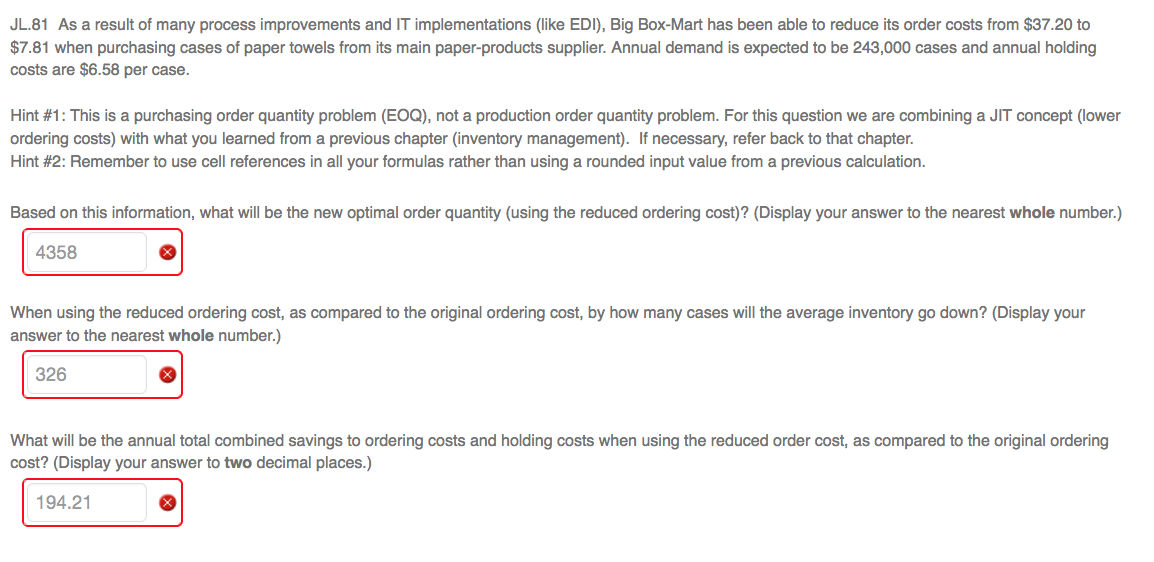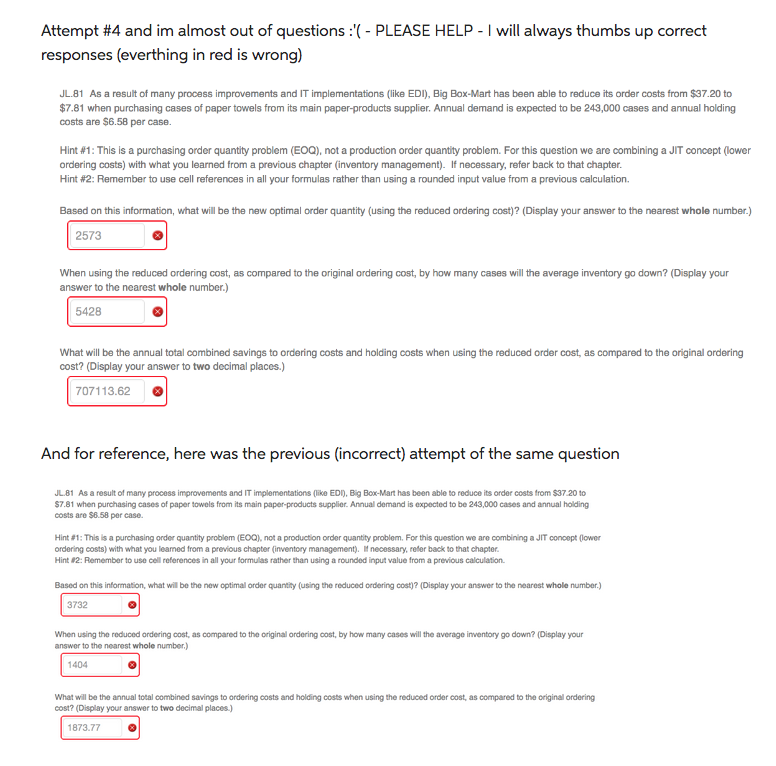This is my fifth try asking the same problem, everything has been wrong up to this point - please help me

Here is a screenshot of some of the other times ive asked the same question on here and gotten wildly different responses :'(

JL.81 As a result of many process improvements and IT implementations (like EDI), Big Box-Mart has been able to reduce its order costs from $37.20 to $7.81 when purchasing cases of paper towels from its main paper-products supplier. Annual demand is expected to be 243,000 cases and annual holding costs are $6.58 per case. Hint \#1: This is a purchasing order quantity problem (EOQ), not a production order quantity problem. For this question we are combining a JIT concept (lower ordering costs) with what you learned from a previous chapter (inventory management). If necessary, refer back to that chapter. Hint \#2: Remember to use cell references in all your formulas rather than using a rounded input value from a previous calculation. Based on this information, what will be the new optimal order quantity (using the reduced ordering cost)? (Display your answer to the nearest whole number.) When using the reduced ordering cost, as compared to the original ordering cost, by how many cases will the average inventory go down? (Display your answer to the nearest whole number.) What will be the annual total combined savings to ordering costs and holding costs when using the reduced order cost, as compared to the original ordering cost? (Display your answer to two decimal places.) Attempt \#4 and im almost out of questions :'( - PLEASE HELP - I will always thumbs up correct responses (everthing in red is wrong) JL.81 As a result of many process improvements and IT implementations (like EDI), Big Box-Mart has been able to reduce its order costs from $37.20 to $7.81 when purchasing cases of paper towels from its main paper-products supplier. Annual demand is expected to be 243,000 cases and annual holding costs are $6.58 per case. Hint \#1: This is a purchasing order quantity problem (EOQ), not a production order quantity problem. For this question we are combining a JIT concept (lower ordering costs) with what you learned from a previous chapter (inventory management). If necessary, refer back to that chapter. Hint N2: Remember to use cell references in all your formulas rather than using a rounded input value from a previous calculation. Based on this information, what will be the new optimal order quantity (using the reduced ordering cost)? (Display your answer to the nearest whole number.) When using the reduced ordering cost, as compared to the original ordering cost, by how many cases will the average inventory go down? (Display your answer to the nearest whole number.) What will be the annual total combined savings to ordering costs and holding costs when using the reduced order cost, as compared to the original ordering cost? (Display your answer to two decimal places.) And for reference, here was the previous (incorrect) attempt of the same question JL.81 As a result of many process improvements and IT implementations (like EDD, Big Box-Mart has been able to reduce its order costs from \$37.20 to $7.81 when purchasing cases of paper towels from its main paper-products supplier. Annual demand is expected to be 243,000 cases and annual holding costs are $6.58 per case. Hint it: This is a purchasing order quantity problem (EOQ), not a production order quantity problom. For this question we are combining a JIT concopt (lower ordering costs) with what you leamed from a previous chapter (inventory management). It necessary, reter back to that chapter. Hint i2: Remember to use cell references in all your formulas rather than using a rounded input value from a previous calculation. Based on this information, what will be the new optimal order quantify (using the reduced ordering cost)? (Display your answer to the nearest whole number.) When using the reduced ordering cost, as compared to the original ordering cost, by how many cases will the average inwentory go down? (Display your answor to the nearest whole number.) What will be the annual total combined savings to ordering costs and holding costs when using the reduced order cost, as compared to the original ordering cost? (Display your answer to two decimal places.)








